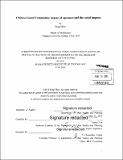Chinese gated community : degree of openness and the social impacts
Author(s)
Chen, Rong, M.C.P. Massachusetts Institute of Technology
DownloadFull printable version (7.727Mb)
Other Contributors
Massachusetts Institute of Technology. Department of Urban Studies and Planning.
Advisor
Tunney Lee.
Terms of use
Metadata
Show full item recordAbstract
Contemporary gated communities in China have only risen to prominence over the past two decades since the Housing Reform and market economy. Research on this field mainly criticize Chinese gated community on their negative social impacts by directly borrowing arguments from the studies of Western gated communities, especially from the US counterparts. However, the socioeconomic connotation attached to gated communities in the US is not necessarily applicable to gating in the Chinese cases. Conceptions of cities in the US as the leading parts of this Chinese urban trend thus have to be questioned and investigated. This paper aims at analyzing the formation of Chinese gated community based on its unique historical context and socioeconomic conditions, and constructing a study framework to measure the degree of openness with its social impact. The historical formation of this peculiar spatial layout derived from a centralized administration concern, which in turn blended into the traditional value as a symbol of social order and belonging. As people's preferences for residence follow the historical traditions and customs, the way residents perceive gatedness is different from the opinions of the Western liberals. Moreover, the current socioeconomic environment contributes to distinguishing the specificities of Chinese urbanization process. The common interests shared by local government, private developers and customers prompt the prevalence of gated communities around the country. Translating the spatial language into measurable quantitative index enables the dissection of the gating phenomenon for objective openness degree assessment. As Chinese gated communities account for a large proportion of the land development, a comprehensive understanding of the measurable openness degree based on local context will better facilitate the research on Chinese gated communities and the rapid urbanization process.
Description
Thesis: M.C.P., Massachusetts Institute of Technology, Department of Urban Studies and Planning, 2014. Cataloged from PDF version of thesis. Includes bibliographical references (page 55).
Date issued
2014Department
Massachusetts Institute of Technology. Department of Urban Studies and PlanningPublisher
Massachusetts Institute of Technology
Keywords
Urban Studies and Planning.